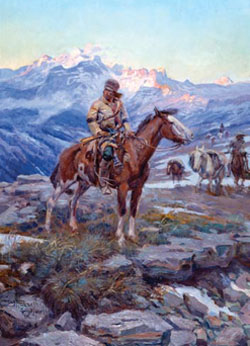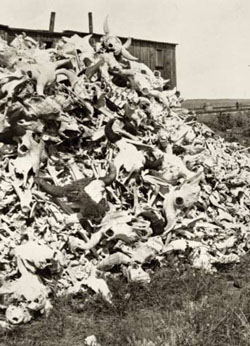Montana: Stories of the Land
Companion Website and Online Teacher's Guide
Chapter 5 - Beaver, Bison, and Black Robes: Montana's Fur Trade, 1800-1860
Chapter 1 - Montana: Where the Land Writes History
Chapter 2 - People of the Dog Days
Chapter 3 - From Dog Days to Horse Warriors
Chapter 4 - Newcomers Explore the Region
Chapter 5 - Beaver, Bison, and Black Robes
Chapter 6 - Montana's Gold and Silver Boom
Chapter 7 - Two Worlds Collide
Chapter 8 - Livestock and the Open Range
Chapter 9 - Railroads Link Montana to the Nation
Chapter 10 - Politics and the Copper Kings
Chapter 11 - The Early Reservation Years
Chapter 12 - Logging in the "High Lonesome"
Chapter 13 - Homesteading This Dry Land
Chapter 14 - Towns Have Lives, Too
Chapter 15 - Progressive Montana
Chapter 16 - Montana and World War I
Chapter 17 - Montanans on the Move
Chapter 18 - The Great Depression Transforms Montana
Chapter 19 - World War II in Montana
Chapter 20 - Building a New Montana
Chapter 21 - A People's Constitution
Chapter 22 - Living in a New Montana
Educator Resources
Educational Trunks
-
From Traps to Caps: The Montana Fur Trade, from the Montana Historical Society. This trunk gives students a glimpse at how fur traders lived and made their living along the creeks and valleys of Montana, 1810-1860. Take a six-minute video tour of some of the objects in the footlocker.
Takeaways
-
Inspired by reading specialist Tammy Elser, who was in turn inspired by SKC graduate Taylor Crawford, we've created a "Takeaway" bookmark for every chapter of Montana: Stories of the Land. Before starting a chapter, print and cut out these bookmarks and distribute them to your students. Ask them to use the Takeaway to summarize the GIST of what they learn from reading assigned sections of the chapter. Remind them that they don't have much room, so they'll need to think before they write down the most important idea they want to take away from the section. Learn a little more about the GIST strategy.
-
Even though we've created Takeaways for every chapter, we don't recommend you have your students complete a Takeaway for every section of every chapter they read. That would be exceedingly tedious. However, used appropriately, they can be a useful tool for encouraging reflection and teaching students how to summarize information.
Websites and Online Lesson Plans
-
Who Are the Little Shell? (Designed for grades 6-8) is a large (17 day) unit that cover the history of the Anishinaabe, the McCumber Commission and the 10-Cent Treaty, Chief Little Shell, the buffalo economy and Red River carts, the Landless Indians of the twentieth century, and the fight for federal recognition. It also answers the questions “Who are the Métis” and introduces students to the Métis Archipelago. The unit can be taught in its entirety, but each subtopic can also be taught independently. Former classroom teacher Anna East and Montana current poet laureate and Little Shell tribal member Chris La Tray created the unit for the Indian Education Division of the Montana Office of Public Instruction.
-
The Gabriel Dumont Institute's Virtual Museum of Métis History and Culture is an amazing clearinghouse of material relating to the Métis. You may wish to direct students conducting projects to the bottom of the Learning Resources page where there is information on many aspects of the traditional Métis culture. You can also find some of their videos on the Gabriel Dumont Institute's YouTube channel.
-
The Utah Education Network has general instructions for creating a school wide Rendezvous where students learn about the fur trade. (This is a big project, with many stations on different relevant topics.)
-
To accompany "The American Buffalo: Spirit of the Nation," an episode of the program Nature, PBS created this website.
-
Fort Union Trading Post National Historic Site has created a 60-minute lesson plan, Fort Union Fur Trade Overview, geared toward third-fifth grade (but it can be adapted upwards), on the fur trade. Included in the lesson plan is a link to short multimedia presentations.
-
The Indian Education Unit at the Montana Office of Public Instruction has a lesson plan on the spread of infectious diseases (particularly the Blackfeet and the small pox epidemic of 1837.
-
The 10,000 Year Significance of Bison: A Curriculum Sequence on the Past, Present and Future of Bison is designed for sixth through ninth grade science, social studies, and language arts classes. In all, five interactive, hands-on, and student-driven units highlight bison’s integral role culturally, politically, socially, and ecologically both before and after Euroamerican contact. Throughout the curriculum sequence, students uncover bison’s dynamic and turbulent past, discover bison’s central placement within Native cultures, and are challenged to critically engage with the processes leading to the near-extinction of bison in the late 1800s. From this understanding, students are tasked with determining potential steps forward in bison restoration and management.
-
The Métis of British Columbia: Culture, History, and the Contemporary Community is an online version of a DVD project created to help disseminate information on Métis history and culture. It includes many short videos, including ones on music and dance and other aspects of culture. There are two main sections: Culture, History, and Dance, and Music and Dance. Although it is from Canada the material is relevant to Montana as well.
-
Deb Mitchell, a program specialist at the Montana Historical Society, created a lesson plan, "Who Are the Métis," to accompany this PowerPoint presentation of the same title.
Videos or DVDs
-
Crossing Boundaries: The Story of Sophie Morigeau, by Salish Kootenai College - 27 minutes. Available through SKC Media (call 406-275-4879 or email roy_bigcrane@skc.edu.)
-
In the Spirit of Atatice, Confederated Salish and Kootenai Tribes, 29 minutes
Possible Field Trips: View the Map
-
Fort Benton, Montana
-
Fort Owen State Park, Stevensville (Related IEFA lesson plans are available.)
-
St. Mary's Mission, Stevensville
-
Fort Union Trading Post National Historic Site, Williston, North Dakota
Chapter 5 Test and Answer Keys Page
The tests and answer keys are password protected.
You can contact us to receive the password:
- Martha Kohl - call (406) 444-4790 or email mkohl@mt.gov
- Melissa Hibbard - call (406) 444-4741 or email Melissa.Hibbard@mt.gov
Or, if you used the old system, the original username is now the new password. You will be asked for this case-sensitive password every time you open a new document.
Alignment to ELA Common Core Standards
Alignment to Content Standards and Essential Understandings Regarding Montana Indians (EU)


